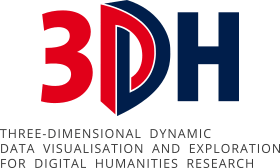
How are visualizations framed? As part of a design session we brainstormed about the ways visualizations are framed:
- They are framed by texts like labels, legends, titles, captions, and other explanatory texts.
- They can have links to other texts, other visualizations, or even help systems.
- They will have controls that are part of the frame of the visualization itself. These controls are sometimes right in the visualization (direct manipulation) and sometimes in separate visual spaces.
- They draw from data that you can sometimes see in other panels or get access to. The data can have different levels in that there could a corpus of texts and then a table of results of a statistical process that is then used to generate the visualization.
- They are created by code which can sometimes be seen. You can see code in a visual programming system or spreadsheets. Some systems will show you the code that is running or give you a space to enter complex queries (which are a higher level of code that acts as a control.) In notebooks the code is visible too.
- There will be a social frame of people interacting with the visualization and “consuming” it. They are made and used by communities whose diversity of values, positions, cultural conventions and mores are part of the conditions of their production, access, and reception. These community frameworks shape the design process. We tend to think of visualizations as being used by one person on a personal computer, but they also show up in presentations before groups of people, on television as part of a mediated presentation, on public displays and over the internet for others to look at. We need to pay attention therefore to the ways that groups of people share visualizations including the ways they show their screens to each other. Who controls group or public visualizations?
Here are some more frames to consider.
- They will have an associated interface like that of a web browser or software.
- There can be computing interface surrounding the visualization on the screen. This might show other applications or controls for the operating system/computer.
- The screen will be a projection surface which has features. A computer screen on a laptop will have a keyboard and webcam attached. A projection on a wall will have other things on the wall. A projection on a building or specially designed surface (like a globe) will be framed by the building or the exhibit design. There may be special controls to an exhibit that are really part of the computing interface. People may be able to use their own devices to send input to a public projection.
- The surface will be part of the infrastructure that makes the visualization possible. That will include the systems, the networking, the electricity, the building and those that maintain them.
- There is a physical site with all sorts of political and cultural issues associated.
- There is a frame of development that creates the visualization, associated data and code. This isn’t necessarily one thing as the data could be created by one group and uploaded to the visualization developed by a different team. The infrastructure could have been developed by yet another group. Development has costs and there are stakeholders like sponsors, granting councils, and universities that provide development support.
- There is an epistemological frame of the tacit and explicit knowledge that is needed to develop and understand the visualization. This can include the new knowledge generated by the visualization and published in different ways. We could have also called this the rhetorical frame in the sense that a visualization is created and used to convey something. It is created and read for pleasure, for information, or to make a point. In this sense there is a performance to the knowing created and explored.
We are obviously pushing the envelope on what is a frame, but the idea was to get a sense of all the things outside the visualization itself that contribute to it. Almost all of these have to be taken into account in an ambitious project like 3DH.

